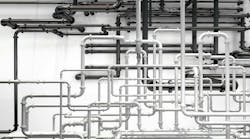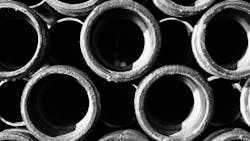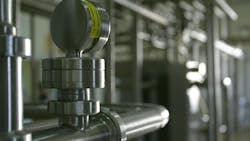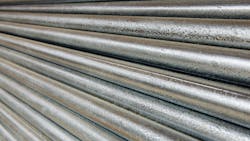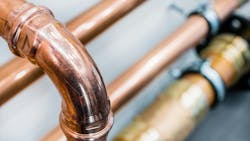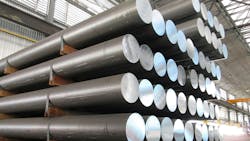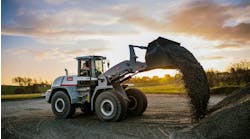Compressed air systems commonly use piping to transport air through the system. The material the piping is composed of can play an important role in the service life of the system.
In part three of Power & Motion’s “Improving Compressed Air System Efficiency” series, it is noted that each piping material has a rating for pressure and temperature. Understanding these and other performance characteristics are critical to ensuring the right material is selected when designing or maintaining a compressed air system, so it not only meets application requirements but also desired service life.
Here we’ve outlined the materials often used for compressed air piping as well as some of the pros and cons of each type to take into consideration when choosing which one to utilize for your compressed air system.
Black Iron
Made with a mild steel compound, black iron piping is considered to be a strong, durable and cost-effective option. It can typically last 15-20 years under normal operating conditions. These characteristics have made it a material many manufacturers choose to utilize for their compressed air piping.
However, this piping material is heavy which requires appropriate anchoring if suspended. This material is also prone to corrosion, often caused by moisture being present in compressed air, leading to potential maintenance issues and a potentially shortened lifespan.
Stainless Steel
Compressed air piping made from stainless steel is considered to be the most durable and corrosion resistant, enabling it to last for 50 years or longer in normal operating conditions.
Like black iron, it is heavy and requires specialized skills to cut and work with it. It is also expensive, making it a less commonly used material despite its high strength and anti-corrosion properties. Pharmaceuticals, laboratories, clean rooms and other applications with strict cleanliness standards often rely on pipes made from stainless steel because there is no risk of corrosion or degradation that could otherwise cause harm.
Galvanized Steel
Galvanized steel has similar characteristics to black iron although it features a protective layer of zinc which helps to prevent corrosion and enables pipes made from this material to last longer than its black iron counterparts.
According to Atlas Copco, it is one of the most commonly used materials for compressed air piping. However, some of the challenges the company points to with galvanized steel is the higher coefficient associated with it. This causes increased pressure drop – a change in the amount of pressure delivered downstream that can negatively impact performance.
Additional challenges with galvanized steel include the fact its zinc coating will flake off over time, leading to blockages within the piping and other maintenance issues.
Copper
Copper is another piping material offering good corrosion resistance and durability, enabling it to last anywhere from 20-50 years. The exact lifespan will be dependent upon the environment in which the piping is used, installation and maintenance. Piping made from this material is lightweight and capable of handling higher pressures.
Challenges with copper include it being susceptible to damage when exposed to chemicals or acidic substances. Cracking of the copper piping can occur as well under some tensile stress conditions as these cause the material to become brittle. Copper is also more expensive, which should be taken into consideration when choosing a material.
Plastic
Plastic is occasionally used for compressed air piping, though according to Unipipe Solutions it is usually not recommended because of the safety and longevity concerns associated with this material. The lightweight, corrosion-resistant and lower cost benefits of plastic may be desirable, but the company notes it is important to confirm with the material manufacturer first if it is rated for compressed air use.
PVC, CPVC, and PEX should never be used for compressed air piping.
Piping made from plastic that is rated for compressed air can last for 10-20 years if properly maintained and regularly inspected for signs of failure. This material can become brittle over time and is susceptible to damage from chemicals and lubricants, all of which can hinder the performance and lifespan of the piping.
Aluminum
Over the last decade, aluminum has become a popular piping material option as it is lightweight, corrosion resistant and easy to install. Modern systems can last 30-50 years or longer.
Reconfiguring piping made from aluminum is easier, as well, helpful for when a facility expands or makes other modifications over time. The smooth interior helps to reduce pressure losses. In addition, it can be used for the transport of air, inert gas, vacuum and high-pressure air or fluids, enabling its use in a range of applications.
By evaluating the pros and cons of each material type in conjunction with the needs of your application, it will be easier to determine the right option for a compressed air piping system.
